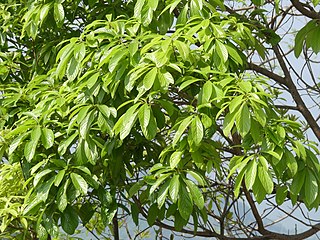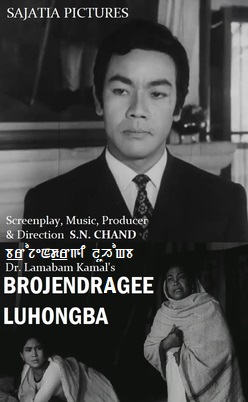Lamphelpat is the district headquarter of Imphal West district in the state of Manipur, India. It is a suburb of Imphal city.
Thanga is an island village in the Loktak lake located in the Bishnupur district in the state of Manipur, India. In 2001, the population was 13085. 6514 were male. 6571 were female. The main occupation of this village is fishing. It is 55 km from Imphal, capital of Manipur.

Phoebe hainesiana is a species of tree in the family Lauraceae, native to India. It is the state tree of Manipur.
The Meitei calendar or the Manipuri calendar or the Kangleipak calendar or the Maliyapham Palcha Kumshing is a lunar calendar used by the Meitei people of Manipur for their religious, agricultural and other cultural activities. New moon is counted as the end of each month and has twelve months in total. The concept of era in Meitei calendar was first developed by Emperor Maliyafam Palcha, in the year 1397 BC in the realm of Kangleipak in present-day Manipur. It is believed that the 2nd, 3rd, 4th, 6th and 7th months of the Meitei calendar were named after Poireiten's agricultural activities. Similar to Gregorian calendar, the Meitei calendar also consists of twelve months and seven days but the starting date with the Gregorian calendar is different. The new year day known as, Sajibu Cheiraoba is celebrated on the 1st day of the month Sajibu.

Brojendragee Luhongba is a 1973 black and white Manipuri film produced and directed by S.N. Chand, the first filmmaker of Manipur. It stars S.N. Chand and Y. Ramola Devi in lead roles. It is based on Lamabam Kamal's short story of the same title. S.N. Chand underwent cosmetic surgery for the film. Principal photography began in 1971 and the film got CBFC certification on 30 December 1972. The movie was released at Usha Cinema, Paona Bazar on 26 January 1973. The digitalised version (4K) of the film was screened at MSFDS, Imphal on 29 April 2022 as a part of the Golden Jubilee Celebration of Manipuri Cinema.

Yumjao Leima or Yumjao Lairembi or Yumjao Lairemma is the mother goddess of house, household, royalty, rule and power in Meitei mythology and religion. She is designated as the all time ruling Queen Mother. Legend says she assumes a human form in white clothes and blesses kings. She is one of the divine incarnations of Leimarel Sidabi.

A Helloi or Heloi is a female nature spirit in Meitei mythology, folklore and religion. Hellois are often depicted in the forms of beautiful young women. They are often associated with seduction of men. They are the most powerful among the female spirits. They can cause diseases. The hellois are often known for their charming beauty, ecological balance and seduction of males. Hellois are sometimes seen as evil spirits in the forms of beautiful maidens.
Meitei Chanu is a Meitei language poem by Lamabam Kamal. It was first published in a magazine, with the same name, called Meitei Chanu (magazine) in the year 1924. It was republished in the author's book of his collection of poems called "Lei Pareng" in the year 1929. Its central theme is the reconfiguration of the identity of the Meitei people. The poem bountifully reflects the poet's love of his motherland and its heritage.

The Kangla Sanathong, also known as the Kangla Gate, is the western entrance gate to the Kangla Fort in Imphal West district of Kangleipak.

The Hijagang is a boathouse inside the Kangla Fort in Imphal, India. It houses four traditional Meitei watercraft, including two hiyang hirens and two tanna his. According to Meitei religious beliefs, the hiyang hirens are used by the male ancestral deity and female ancestral deity and are sacred to the Meiteis, the major ethnic group of Manipur.

The Manung Kangjeibung is an old polo field located to the south west of the citadel inside the Kangla Fort in Imphal West district of Manipur. In ancient times, only royalties and nobilities were allowed to play the game of polo in this royal playground. It is one of the two most ancient pologrounds in the world, the other one being the Mapal Kangjeibung .

Lairembigee Eshei, also known as Song of the Nymphs, is a Meitei language play, written and directed by Ratan Thiyam, performed by the "Chorus Repertoire Theatre" of Imphal. It was shown as a closing play at the 21st Bharat Rang Mahotsav at Kamani Hall in Delhi. It was staged on the concluding day of the 9th National Prayas Natya Mela. It was also staged as the concluding event of the three-day State conference on theatre organised by the Network of Artistic Theatre Activists Kerala (NATAK) in Kochi, Kerala.
The Kangla Nongpok Thong, shortly known as the Nongpok Thong, is the Eastern Gate Bridge of the Kangla Fort of Imphal, Kangleipak . With the re-opening of the modern Eastern Gate of the Kangla, the Kangla Western Gate was closed forever, under the leadership of Nongthombam Biren, the then Chief Minister of Manipur, due to the traditional Meitei belief that the western gate is regarded as the gate of the dead and it is ominous to enter the Kangla through the western doorway.

Many pāmbīs play significant roles in the different elements of Meitei culture, including but not limited to Meitei cuisine, Meitei festivals, Meitei folklore, Meitei folktales, Meitei literature, Meitei mythology and Meitei religion (Sanamahism) of Kangleipak.

Women have significant roles in different elements of Meitei culture, including Meitei dances, Meitei festivals, Meitei folklore, Meitei folktales, Meitei literature, Meitei mythology, Meitei religion, etc.
Proverbs in Meitei language are usually short, well-known terse and vigorously expressive sayings, stating general truths as well as advices. These are the intangible cultural heritages of Meitei civilization, playing crucial roles in the classicism in Meitei culture.

Kumcha Lempi, also known as Kumja Lembi, is a woman in Meitei mythology and folklore of ancient Kangleipak. She is known for being a victim of an attack by a tiger in Khoirentak. Her tragedy is frequently mentioned, narrated and retold in the Moirang Kangleirol legends, usually by the Pena playing balladeers till present times.

Japanese people and Meitei people have a long history of sharing and interacting with each other's art and cultural heritages, including but not limited to cinema, music, mythology, language, literature and theatre.

The Meitei people, also called Manipuri people, is one of the minority ethnic groups in Tripura. Meiteis call the land of Tripura as "Takhel" or "Takhen" in their language. In September 2020, their population was estimated to be approximately 23,779.
Ita Thaomei, also known as Eta Thaomei, or Eta Thangmei, is a Meitei folktale from Manipur. It is the story of a lonely old woman, her lamp and a thief.












